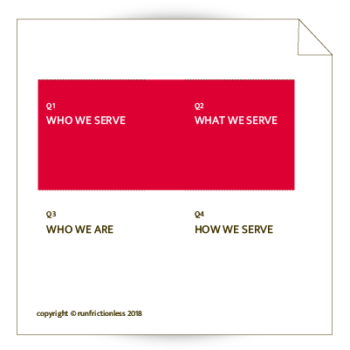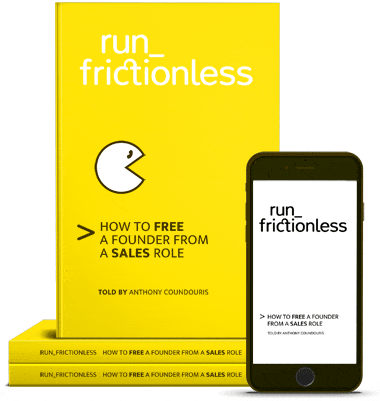Should you serve enterprise or small business? Try this decision-making framework.
>
Should I serve SMB or enterprise customers? Which is better?
A decision-making framework like the 4Qs can help make a comparison 🔍 of the two profiles easier. Deciding who to serve without a decision-making framework is like deciding the fate of the business on a 🤞 coin toss. The outcome of many other decisions, and indeed the fate of the business could rest upon this single decision.
A decision-making framework can reduce procrastination and help the business owner or sales team confidently evaluate the two profiles, based on nine simple data points.

Quick sanity check
With limited resources, who will you serve 🙌 today, tomorrow, and never serve? Before trying to answer, there are a few things you should know.
Firstly, enterprise decision-makers and small business owners are two ✌ divergent profiles. Our research shows you can create a small business customer in 10-15 interactions. If you are serving enterprise decision-makers, you need to support from 25 up to 50 interactions.
Secondly, an organization is unlikely to have enough capital to serve both. It makes sense for your organization to serve enterprise decision-makers today and serve small business owners tomorrow. Or vice versa.
Lastly, I’d like to point out that small businesses don’t buy. Small business owners buy ☝. The same applies to the enterprise. There are enterprise decision-makers, but the enterprise as an entity does not buy. In my experience, it is better to skew profiling towards decision-makers and place less emphasis on company size and sector.
Enter the 4Qs
I would like to introduce a decision-making framework called the 4Qs. The 4Qs is a decision-making framework designed to help founders and sales teams 🏆 scale a business.
The 4Qs are short for Four Quadrants. The decision-making framework encourages users to ‘play’ 🕹 or ‘fit one quadrant with another. Although all four quadrants are distinct, each quadrant is interdependent. A decision made in one quadrant will present decisions to be made in one or more other quadrants.
Quadrant 1 addresses whom we serve. The remaining three Quadrants deal with what we are serving the customer, what we share in common with the customer, and how we serve the customer.

get to predictable revenue quicker
Deciding which profile to serve is necessary for striking a Quadrant 1-2 fit. When an organization strikes a Quadrant 1-2 fit, it creates value ✨ for customers and makes revenue for the business. The quicker your organization strikes a Quadrant 1-2 fit, the faster they reach predictable revenue.
The 4Qs decision-making framework can be used to make other types of decisions such as a

Price is not the only factor
Many business owners decide who to serve based on the ticket price of their product. They decide to serve today customers who are prepared to pay more, without considering 👎 the associated costs of serving this profile.
We would like to table another nine data points worth discussing with your sales team before making this decision. Many of these you are familiar with like buying personas. However, I am willing to wager a small sum that you have not come across 😲 customer expiry and buying triggers.
Customer expiry is the length of time a customer consciously or unconsciously allocates to making a buying decision. Every customer’s buying decision has 💥 an expiry. If the buying decision is not closed in the time frame, the customer is likely to drop off and abandon their buying decision. If your customer expires in 90 days, and you design a sales process that creates a customer in 15 days, bad news. You are out of the race.
A buying trigger 🔫 is an event that drives a customer to make a buying decision. Back to school is a trigger for parents to buy stationery for their children. The end of the financial year is a trigger for customers to switch accounting firms. If the date a buying trigger can be predicted, the salesperson has an advantage.
9 simple data points
Assess each of the nine data points. Try to come up with an answer for each based on your discussion 💬 with customers. We have offered answers to each based on our intel. Your answers will differ from ours.
Let’s explore each in turn.
#1 HOMOGENEITY
Unlike small businesses, enterprise organizations are far less likely to exhibit similarities between one another. A common complaint 😓 from business owners who decide to serve enterprise, is they end up creating a different version of their business to serve each enterprise customer.
Despite enterprise organizations sharing a similar sector like logistics, because their businesses are so large with many kinds of legacy systems, each is its own customer profile.
-
🎙️
-
‘We want the same thing – productivity.’
SMALL-BUSINESS OWNER
-
🎙️
-
‘We belong to different verticals with different needs and different legacy systems.’
ENTERPRISE DECISION-MAKER
#2 SOPHISTICATION
Small business owners are often immature, never having experienced a product category before. So they may have few objections because they have no experience buying your product before. For enterprise decision-makers, this may be the fourth or fifth time they have bought this type of product.
They often feel like they know more 📚 about the product category and may request vast customization not available. Rather than purchase what you have in the warehouse, their decision-makers may be more inclined to have to build something from scratch.
-
🎙️
-
‘If that’s what I need, let’s do it.’
SMALL-BUSINESS OWNER
-
🎙️
-
‘We will show you how you should have built your product.’
ENTERPRISE DECISION-MAKER
#3 EXPECTATION
Small business owners do not have time to interrogate your business. Many of them will refuse to meet in-person because they are busy juggling many roles and cannot afford the travel time. Small business owners will hand you their trust ❤️ quicker, allowing you to get on with serving them.
Enterprise decision-makers have many boxes to tick before they will grant you their trust. Each decision-maker will want to ✅ test and measure your organization. They are more likely to request RFPs, proposals, cost schedules, and meetings at their offices.
-
🎙️
-
‘I will make a decision after two phone calls together.’
SMALL-BUSINESS OWNER
-
🎙️
-
‘We want a proposal, lots of meetings, and a bunch of changes to the product.’
ENTERPRISE DECISION-MAKER
#4 BUYING PERSONAS
It is important to understand that small businesses and enterprises ⛔ don’t buy. It is the small business owners and enterprise decision-makers who buy. In an enterprise organization, there could be multiple stakeholders involved in a buying decision. Influencers, users, and buyers to name a few.
In a small business, nine times out of ten, the decision rests solely 👏 with a managing director or owner.
-
🎙️
-
‘It is just me.’
SMALL-BUSINESS OWNER
-
🎙️
-
‘You need to convince me, my boss, his boss, and the board.’
ENTERPRISE DECISION-MAKER
#5 VALUE
Does your organization provide a must-have or a nice-to-have product? Organizations that are valuable are harder to substitute later ✂️ for a competitor. To become a must-have product for an enterprise organization is difficult because enterprise businesses have many departments. To be a must-have, you will need to improve not one but many departments.
Creating value for a small business owner is easier and requires less capital raising because their businesses are flatter.
-
🎙️
-
‘You guys are mission-critical. My entire business runs on you.’
SMALL-BUSINESS OWNER
-
🎙️
-
‘You’re a nice-to-have. We could buy you.’
ENTERPRISE DECISION-MAKER
#6 INTELLIGENCE GATHERING
Your organization cannot succeed if you serve customers who give you open and honest feedback. When an enterprise decision-maker tells you ‘we will get back to you’, 📣 what they really mean is, ‘I’ll never tell you what I really think’. Your organization is often a pawn in a political and power struggle. Small business owners only have their time to lose by giving you feedback.
-
🎙️
-
‘I’ll tell you all our pain points right now.’
SMALL-BUSINESS OWNER
-
🎙️
-
‘We’ll get back to you.’
ENTERPRISE DECISION-MAKER
#7 PRICE SENSITIVITY
Decision-makers take on very different behaviors when they are personally paying for a product or service from their own money. Even though it is a business cost, your fees eat 👎 into their profit, which affects how much money they can take home that week.
That’s why small business owners are likely to be price-sensitive compared to enterprise decision-makers.
Free trials and discounts are likely to appeal to this group but are less likely to appeal to enterprise decision-makers. In fact, the internal costs 🔔 for an enterprise organization to switch to your product may be higher than the price you are asking them to pay, meaning price is not part of their decision-making.
-
🎙️
-
‘Hey. This is coming out of my own pocket.’
SMALL-BUSINESS OWNER
-
🎙️
-
‘We are used to paying through the nose.’
ENTERPRISE DECISION-MAKER
#8 CUSTOMER EXPIRY
I have personally witnessed small-business owners expire in less than two hours. They begin researching a product at 7pm once they close trading, and by 9pm, they have made up their minds. A similar product from the same product category could take an enterprise decision-maker 🧨 90 days or longer before they expire.
Even though it can be more difficult to serve customers who 💥 expire quickly, serving this customer means less chance of revenue lag. Revenue lag is the distance between when you predict to get the cash into the bank account and the actual date the cash arrives.
#9 BUY TRIGGERS
Knowing the buying trigger 🔫 makes predicting revenue easier. In other words, it’s like having the money already in the bank. You don’t need to concern yourself with drip campaigns and hit and miss telephone calls. All you have to do is stand at the intersection where the decision will take place, and you have good odds of closing the sale.
Under normal circumstances, it is easier to discover what triggers a 😇 small business owner to make a buying decision over an enterprise decision-maker. Enterprise decision-makers are less transparent.
-
🎙️
-
‘I have two projects to talk about right now.’
SMALL-BUSINESS OWNER
-
🎙️
-
‘When the boss comes to town.’
ENTERPRISE DECISION-MAKER

get started
using the
4Qs
FREE RESOURCES
Key takeaways

run frictionless
now for only US$995







